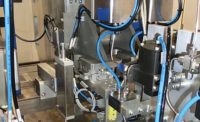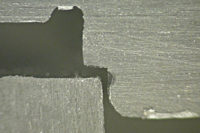Based in Northbrook, IL, Concep Machine Co. has been designing and building custom automated assembly systems for the medical device manufacturing industry since 1967. The company has built automation systems to assemble and test drug delivery devices, such as syringes and cartridge pumps; IV components and tubing sets; IV pouches; catheters; cannulae; and diagnostic cassettes.
In particular, Concep excels at building cam-controlled, synchronous assembly machines. Using precision-cut cams to control tooling motions offers the highest repeatability and reliability. By driving all cams with a common drive, these machines offer the highest efficiency or lowest cost to operate. Cam-actuated machines provide a lower mean time between failures than any other means of process automation.
Regardless of what type of system is used to assemble your medical device, these 10 tips provide a roadmap for creating an automated assembly line that is efficient and cost-effective.
Design parts for manufacturability. If the parts do not join together in a robust manner, the automation will not be reliable and will not provide high-quality assemblies. The fit of each part to another is critical for a successful automation process. It is important to consider designing-in features that help guide the parts together. Lands, chamfers and assembly guides go a long way in supporting the assembly process. Engineers should also try to design parts so that they go together without special tooling considerations.
Establish stable dimensional quality of the parts. It is often said that assembly automation is the most demanding inspection machine that you can buy. Grippers, tooling and other components will operate more reliably when the parts they are handling have stable dimensions. If dimensions are not within the tolerance range that has been provided to the automation supplier, parts can jam in the machine. Make sure the dimensions and tolerances specified in the part prints reflect what can be achieved in actual production.
Prototype high-risk processes. Sometime during product design or the beginning of the development of a user requirement specification (URS) for an automation system, vendors may identify areas of the assembly process that demonstrate a high risk or require a new concept for tooling. In such instances, the development of a prototype can be used to confirm the process or tooling approach. These prototypes are most helpful if the sample parts are in a stable design stage. Developing production tooling at this stage with a simple prototype can confirm the feasibility of the process, as well as whether it will work within a cycle time window, generate any particulate, or damage the assembly.
Identify automation preferences. After obtaining feedback on the assembly processes, the next step is to make some fundamental choices regarding the type of machine that is desired. Feed rate becomes an important factor at this stage of development. For example, pneumatic actuators are often a good choice for automated assembly systems. However, they can only work so fast without sustaining premature wear. Cam-actuated processes, on the other hand, will provide much higher machine speeds, but require a higher investment than pneumatic systems.
Develop a detailed and complete URS. The URS is an important guide for the automation project as it will enable suppliers to provide accurate and complete proposals for the equipment. The manner in which customers write the URS varies widely; some are very detailed while others are intentionally vague and open to interpretation. In either case, the “must haves” for the project must be clearly defined to ensure success.
Choose a vendor through thorough review. Supplier selection for an application should be determined through a systematic comparison; each supplier should be evaluated based on the strengths and weaknesses of its approach. Careful weighting needs to be given to various aspects of the proposed machine, from cycle rate to floor space to the inclusion of various quality inspections.
Perform a robust process failure modes and effects analysis (PFMEA). A complete and detailed PFMEA provides invaluable information about the machine process. High risk-priority numbers are a strong indication that a process is not going to be robust in a machine, or that it will be a high-maintenance area once the machine enters production. Modification of the process or detection methodology is a low-cost, low-risk solution for the automation at this phase of the project. Making these changes early in the engineering stage of the machine also lessens the cost impact to the overall project.
Develop a project plan. The project plan should contain key dates for the project schedule and show both supplier and customer inputs for the project. For example, it’s important for all parties involved to see such milestones, including when the customer needs to supply parts in quantity and the date of “power on” for the system from the supplier.
Monitor the project plan often. Once the project plan has been developed, it needs to be reviewed and maintained as a living document. It should be reviewed whenever the project team has a major meeting or review event. The plan should show both the original base line and real-time adjustments that have been implemented to accommodate changes in the project schedule. This approach becomes vitally important during the debug phase of machine development. Debug is the phase when unexpected time may need to be allocated in the schedule to solve a problem on the machine that could not be foreseen and is not apparent until the system is under power and beginning to cycle.
Take ownership. The ultimate owner of the machine process is the customer who purchases the equipment. Therefore, the earlier that the customer’s team takes part in machine development, the smoother the transition to ownership will be. Working side by side with the supplier gets the engineers and technicians who will maintain the equipment involved and comfortable with the machine.
For more information on assembly automation for the medical device industry, click http://concepmachine.com.





